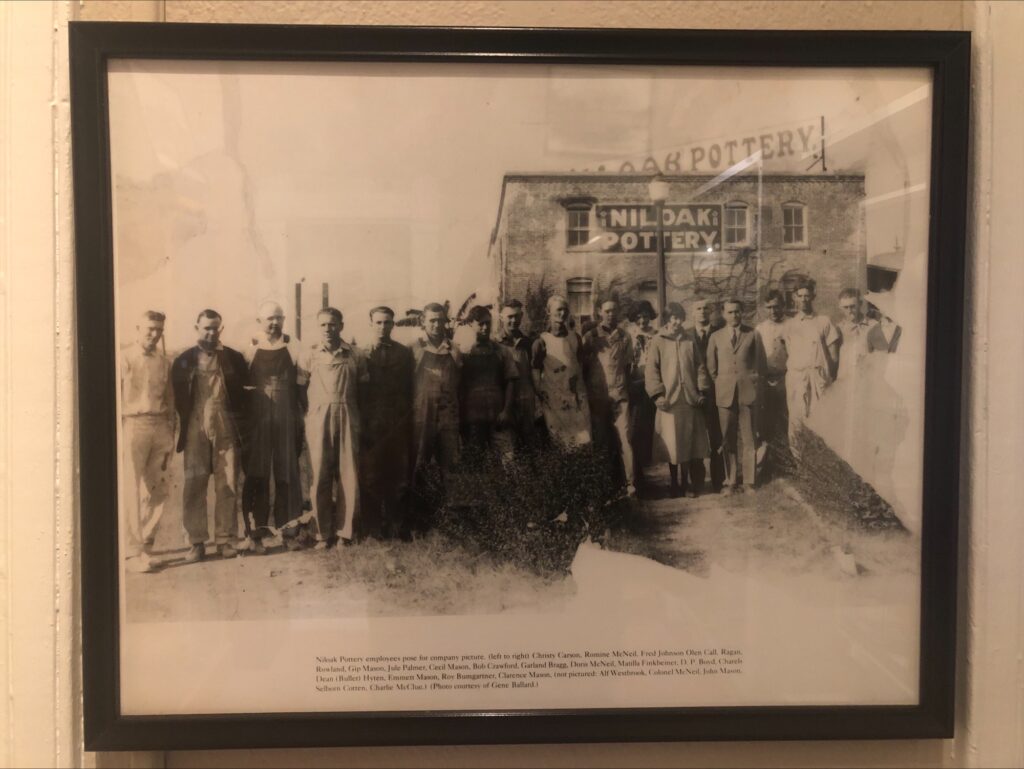Frequently Asked Questions: How was Niloak Pottery made?
By Cody Berry
One of the things that the Gann Museum is known for is its collection of Niloak Pottery. We keep it on permanent display in Dr. Gann’s old exam room. When I give tours of the museum people usually comment on how pretty the pottery is. They also want to know how it’s made, so I did some reading on this topic last week. In the second edition of his book “The Collector’s Encyclopedia of Niloak,” David Edwin Gifford shed some light on the topic. But I still don’t know where all of the clays those potters used came from.
I learned that Dr. Gann, Sr was on the list of organizers of the Niloak Pottery company when it formed in 1909. Eagle Pottery owner Charles Hyten and potter Arthur Dovey were on the list as well. Together, those early organizers raised $10,000 in capital stock with another $2,000 invested to start the company. With that Money, Hyten had his pottery plant built on Pearl Street in Benton.1 We have a photograph of it in the exam room.

Pictured above: Niloak Potery employees pose for a company picture; on display at the Gann Museum.
I also learned that the process for clays used for making pottery took at least a week after obtaining it. After the “initial mud grinding and mixing (with the removal of grit or other trash), the clay was placed into a mill for the final grinding process and then soaked in vats of water.”2 Then the clay was put through a mesh wire screen and dried. Blending colors is what took the most time. Additives such as cobalt (blue), ferric oxide (red), chromic oxide (grey), and white clay (white) were put in and mixed as needed. Different color clays were then stacked and cut with a stretched wire. After being thrown, the pieces were trimmed and smoothed on a horizontal lathe. The combination was 90% clay and 10% additives.3
After reading Charles Hyten’s formual books at the Gann Museum we now know that lead was also used at some point in the glazing process. Back then it may have been common but now we know that lead is toxic and could be deadly. So, I hope if anyone has Niloak cups or bowls, they aren’t actually eating or drinking out of them. Niloak is still very valuable, and it does have a following. The Spanish style Nilaok showroom once sat on Military Road in an area now called Niloak Square. It was torn down in the 1970’s.4
Citations:
1 David Edwin Gifford, The Collector’s Encyclopedia of Niloak Reference and Values,” Second Edition, Collector Books: Paducah, Kentucky, 2001, p. 15.
2 David Edwin Gifford, The Collector’s Encyclopedia of Niloak Reference and Values,” Second Edition, Collector Books: Paducah, Kentucky, 2001, p. 38-39.
3 David Edwin Gifford, The Collector’s Encyclopedia of Niloak Reference and Values,” Second Edition, Collector Books: Paducah, Kentucky, 2001, p. 38-39.
4 David Edwin Gifford, The Collector’s Encyclopedia of Niloak Reference and Values,” Second Edition, Collector Books: Paducah, Kentucky, 2001, p. 24.
